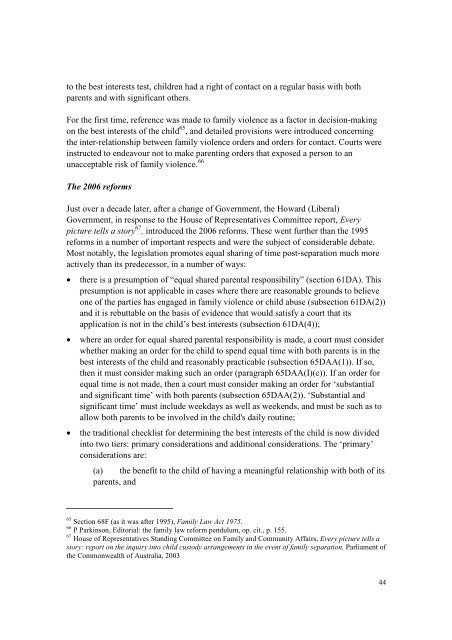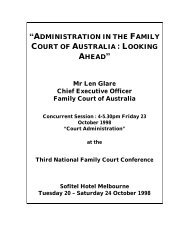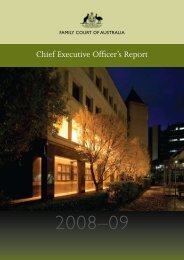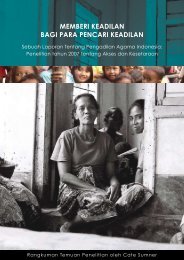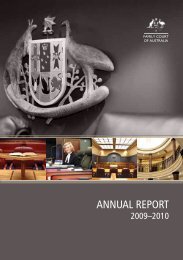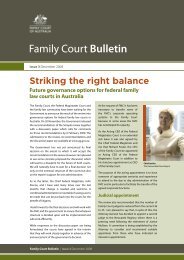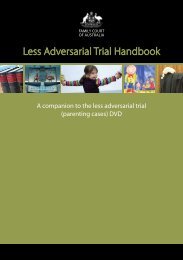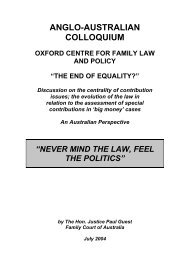to <strong>the</strong> best interests test, children had a right of contact on a regular basis with bothparents <strong>and</strong> with significant o<strong>the</strong>rs.For <strong>the</strong> first time, reference was made to family violence as a factor in decision-makingon <strong>the</strong> best interests of <strong>the</strong> child 65 , <strong>and</strong> detailed provisions were introduced concerning<strong>the</strong> inter-relationship between family violence orders <strong>and</strong> orders for contact. Courts wereinstructed to endeavour not to make parenting orders that exposed a person to anunacceptable risk of family violence. 66The 2006 reformsJust over a decade later, after a change of Government, <strong>the</strong> Howard (Liberal)Government, in response to <strong>the</strong> House of Representatives Committee report, Everypicture tells a story 67 , introduced <strong>the</strong> 2006 reforms. These went fur<strong>the</strong>r than <strong>the</strong> 1995reforms in a number of important respects <strong>and</strong> were <strong>the</strong> subject of considerable debate.Most notably, <strong>the</strong> legislation promotes equal sharing of time post-separation much moreactively than its predecessor, in a number of ways:• <strong>the</strong>re is a presumption of “equal shared parental responsibility” (section 61DA). Thispresumption is not applicable in cases where <strong>the</strong>re are reasonable grounds to believeone of <strong>the</strong> parties has engaged in family violence or child abuse (subsection 61DA(2))<strong>and</strong> it is rebuttable on <strong>the</strong> basis of evidence that would satisfy a court that itsapplication is not in <strong>the</strong> child’s best interests (subsection 61DA(4));• where an order for equal shared parental responsibility is made, a court must considerwhe<strong>the</strong>r making an order for <strong>the</strong> child to spend equal time with both parents is in <strong>the</strong>best interests of <strong>the</strong> child <strong>and</strong> reasonably practicable (subsection 65DAA(1)). If so,<strong>the</strong>n it must consider making such an order (paragraph 65DAA(I)(c)). If an order forequal time is not made, <strong>the</strong>n a court must consider making an order for ‘substantial<strong>and</strong> significant time’ with both parents (subsection 65DAA(2)). ‘Substantial <strong>and</strong>significant time’ must include weekdays as well as weekends, <strong>and</strong> must be such as toallow both parents to be involved in <strong>the</strong> child's daily routine;• <strong>the</strong> traditional checklist for determining <strong>the</strong> best interests of <strong>the</strong> child is now dividedinto two tiers: primary considerations <strong>and</strong> additional considerations. The ‘primary’considerations are:(a) <strong>the</strong> benefit to <strong>the</strong> child of having a meaningful relationship with both of itsparents, <strong>and</strong>65 Section 68F (as it was after 1995), <strong>Family</strong> Law Act 1975.66 P Parkinson, Editorial: <strong>the</strong> family law reform pendulum, op. cit., p. 155.67 House of Representatives St<strong>and</strong>ing Committee on <strong>Family</strong> <strong>and</strong> Community Affairs, Every picture tells astory: report on <strong>the</strong> inquiry into child custody arrangements in <strong>the</strong> event of family separation, Parliament of<strong>the</strong> Commonwealth of Australia, 200344
(b) <strong>the</strong> need to protect <strong>the</strong> child from harm or from being exposed to abuse,neglect or violence (subsection 60CC(2))• <strong>the</strong>se primary considerations have been described as “<strong>the</strong> twin pillars” of <strong>the</strong>parenting provisions in Part VII;• <strong>the</strong> ‘additional’ considerations (subsection 60CC(3)), are those from <strong>the</strong> traditionalchecklist, with <strong>the</strong> notable addition of <strong>the</strong> so-called ‘friendly parent’ provision(paragraph 60CC(3)(c)), which requires a court to take account of <strong>the</strong> willingness ofeach parent to facilitate a close relationship between <strong>the</strong> child <strong>and</strong> <strong>the</strong> o<strong>the</strong>r parent;• parents are required to attend family dispute resolution (FDR) <strong>and</strong> obtain a certificatefrom an FDR practitioner before <strong>the</strong>y can apply to court for parenting orders, unless<strong>the</strong>re are concerns about family violence <strong>and</strong> abuse or o<strong>the</strong>r exceptions, includingurgency (section 60I).The legislation was accompanied by a significant investment in new community- basedFDR services, including <strong>Family</strong> Relationship Centres, <strong>and</strong> in o<strong>the</strong>r specific forms ofservice provisions such as contact centres.Review of <strong>the</strong> 2006 reformsSince <strong>the</strong> introduction of <strong>the</strong> 2006 reforms, <strong>the</strong>re have been a number of reviews <strong>and</strong>inquiries into family law matters including <strong>the</strong> issue of family violence <strong>and</strong> child abuse.In <strong>the</strong> context of <strong>the</strong> <strong>Family</strong> <strong>Violence</strong> Act, <strong>the</strong> more significant of <strong>the</strong>se reports 68 are:• <strong>the</strong> Evaluation of <strong>the</strong> 2006 family law reforms, by <strong>the</strong> Australian Institute of<strong>Family</strong> Studies (<strong>the</strong> AIFS Evaluation) 69• <strong>the</strong> <strong>Family</strong> Courts <strong>Violence</strong> Review, by <strong>the</strong> Honourable Professor RichardChisholm (<strong>the</strong> Chisholm Review) 70• Improving responses to family violence in <strong>the</strong> family law system: An advice on <strong>the</strong>intersection of family violence <strong>and</strong> family law issues, a report by <strong>the</strong> <strong>Family</strong> LawCouncil (<strong>the</strong> <strong>Family</strong> Law Council Report). 7168 Ano<strong>the</strong>r relevant report, conducted by <strong>the</strong> Australian <strong>and</strong> New South Wales Law Reform Commissionsaddressed <strong>the</strong> issue of inconsistencies in <strong>the</strong> interaction <strong>and</strong> application of <strong>the</strong> Commonwealth <strong>and</strong> Statesregarding domestic violence, child protection, sexual assault <strong>and</strong> family law. Australian Law ReformCommission, ‘<strong>Family</strong> violence: a national legal response’, Report, no. 114, 2010,http://www.alrc.gov.au/publications/family-violence-national-legal-response-alrc-report-11469 R Kaspiew et al, Evaluation of <strong>the</strong> 2006 family law reforms, 2009, Australian Institute of <strong>Family</strong> Studies,http://www.aifs.gov.au/institute/pubs/fle/index.html70 R Chisholm, <strong>Family</strong> Courts <strong>Violence</strong> Review, 2009,http://www.ag.gov.au/www/agd/agd.nsf/Page/Families_<strong>Family</strong>Courts<strong>Violence</strong>Review71 <strong>Family</strong> Law Council, Improving responses to family violence in <strong>the</strong> family law system: An advice on <strong>the</strong>intersection of family violence <strong>and</strong> family law issues, 2009,http://www.ag.gov.au/www/agd/rwpattach.nsf/VAP/(3273BD3F76A7A5DEDAE36942A54D7D90)~<strong>Family</strong>_<strong>Violence</strong>_Report.pdf/$file/<strong>Family</strong>_<strong>Violence</strong>_Report.pdf45


